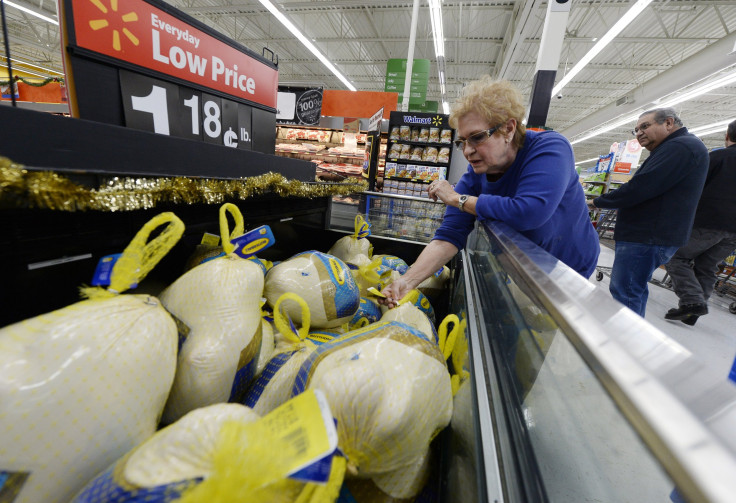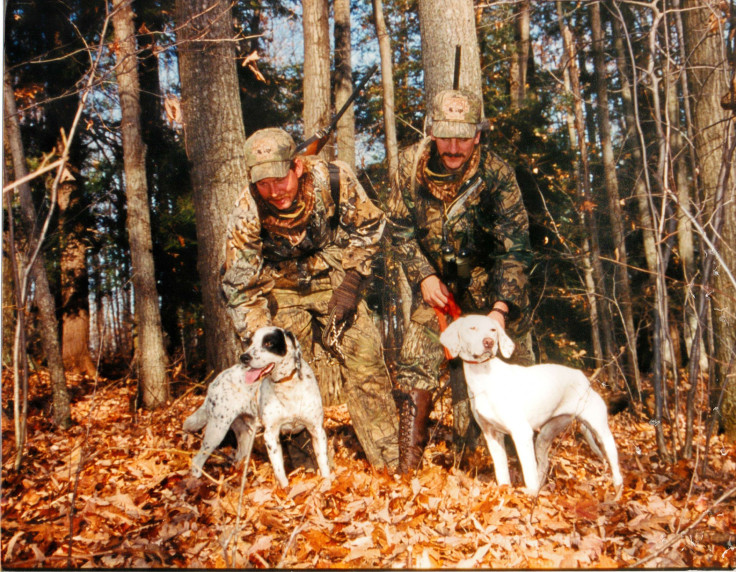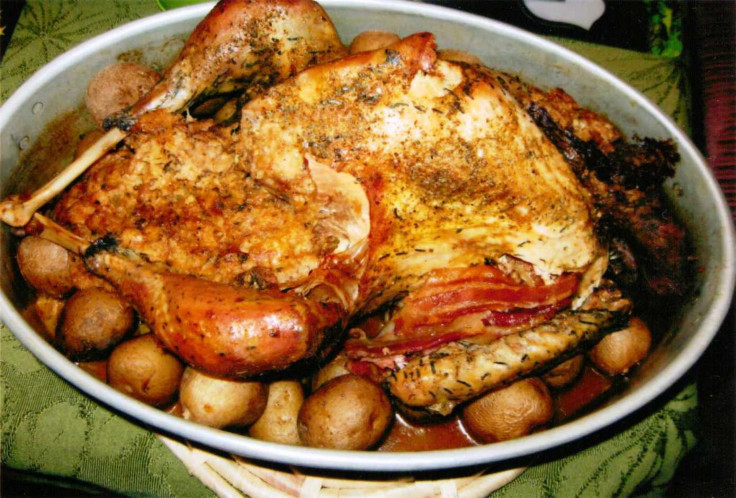Ode To The Wild Turkey: American Comeback Story And Thanksgiving Tradition

The Thanksgiving bird that most of us feast upon this holiday season would have astonished the Pilgrims and Native Americans of the 1600s. Today’s turkeys are fatty beasts bred to have oversized chests -- large enough that a factory-farmed Tom can’t actually have intercourse with a hen, because his massive breast gets in the way. Odds are nearly 100 percent that your Butterball was conceived through artificial insemination.
If you want a more authentic Thanksgiving dinner (and a different taste treat for the leftovers you’ll likely consume this weekend and beyond), why not try wild turkey? It may require adjusting your recipe and cooking time, since a wild bird tends to be lighter and leaner. And it might be a bit trickier to track one down. But if you live near a meat shop with slightly more exotic tastes, or a friendly hunter, it could transform your holiday.
There’s never been a better time to consider alternatives to the factory-farmed turkey: Butterball, the company responsible for a fifth of the gobblers that end up on plates across America, has run into a bit of a problem: A shortage of large, fresh birds this holiday season. The company has stayed mum about the cause of the shortage. Mother Jones writer Tom Philpott presented a number of possible explanations, ranging from marketing stunt to a rise in corn prices or the fact that Butterball might be phasing out its use of a certain weight-gaining drug to better compete in markets abroad. Whatever the reason, it illuminates how much our holiday rests on a narrow definition of acceptable turkey meat.
“I never considered it might taste any different than the dozens of grocery-store turkeys I'd eaten, but there was no comparison,” outdoor writer Keith Sutton said of the first wild bird he shot and cooked. It “possessed the distinctive savory goodness that is always apparent when one eats an animal that has made its living foraging on natural bounties. I could taste the wildness of the Ouachita Mountain backcountry in every bite, and it sharpened my hunger for a return visit -- all a person could ask from a meal.”
Gobble softly and carry a big shotgun
“There’s some things that certain people get addicted to -- golf, bowling, badminton,” says Pete Clare. “I got addicted to turkey hunting.”
Clare first started hunting turkeys in the 1970s, and his passion became a full-time occupation. For 26 years, he’s operated Turkey Trot Acres, a hunting lodge in Candor, N.Y., just 16 miles from the Pennsylvania border.
Turkey hunting falls into two distinct seasons (exact dates vary from state to state). In spring, the breeding season, females are off-limits to hunters. The birds also tend to be scattered around more, so the general approach to hunting is to find a place where the turkey might be expected to pass, and to imitate the sound of a hen to attract an interested male.

Hunting in the fall is a different story: The birds clump together in gregarious flocks (also known as gangs, bales or rafters). Clare prefers hunting with bird dogs; his breed of choice is the Appalachian turkey dog. The dogs range ahead of the hunters, sniffing for signs of a flock. Once on the trail, the dogs rush into the flock and bark up a storm, scaring the turkeys and scattering them to the wind. The hunters follow up to that same spot, which is called the “break point,” and wait for the flock to reconvene.
“Turkeys don’t like being alone,” Clare explains. “They want to get back together.”
While the hunters are waiting, they imitate turkey calls to encourage the birds to come back to the meeting place. The wild turkey makes a lot of different noises, and the experienced hunter chooses among lots of different calls as the situation demands. A “kee kee,” the call of a lost young turkey, can be an effective way to reassemble the flock, as is the “assembly call,” which is the sound a hen makes when trying to gather her babies together. A “plain yelp” is the most basic call. A “purr” can reassure a hesitant turkey into coming closer to you, while a “putt,” the sound that turkeys make when alarmed, can be a good way to stop a Tom in his tracks and get him to raise his head, for better aim.
The hunter can try and imitate turkey calls with his own voice, or use special devices made from wood, slate, or other materials. And if you don’t find technology antithetical to the spirit of the thing, there’s an app for it, of course.
“I think the reason why people get addicted to [turkey hunting] is the communication,” Clare says. “With deer hunting, you have to sit in a stand and wait and wait. The fun with turkeys is there’s this two-way communication. Making the calls stimulates the hunter. That’s sort of what the mystique is -- you have to fool the wild beast.”
The turkey has to be lured into shotgun range – about 30 to 40 yards. The shotgun or the bow are usually your only weapons of choice (regulations, again, vary by state). Hunters aim for the head, since a hit to the turkey’s substantial breast won’t get through to the vitals, Clare says. A turkey peppered with shots below the neck will probably still die, but only after flying off – a wasted death.

How you clean and prepare the turkey is up to you. At Turkey Trot Acres, some hunters pluck their birds to leave the skin on for whole roasting; others skin the birds and piece them out. Clare’s favorite recipe is to cut the breasts into strips, marinate them, bread them, and fry them up like chicken tenders. Cooking a wild turkey in the oven is much different from cooking a grocery store turkey: Since the meat has less fat, it’s easier to overcook and end up with a drier bird.
If hunting a turkey isn’t feasible, and you still want to avoid the typical grocery store variety, you might want to try a heritage breed. Butterballs and their ilk are Broad Breasted Whites, but there’s a whole spectrum of less common breeds to choose from: the Royal Palm, which is a white turkey with beautiful metallic black touches; the Bourbon Red, a handsome bird done up in tones of chestnut and mahogany; or the Standard Bronze, once the favored breed of turkey before it was supplanted by the Broad Breasted White, which has a cleaner-looking carcass, according to the Livestock Conservancy.
But hunting a turkey is still the most visceral way for you to connect to the Thanksgiving meal.
“Our hunters, when they cull turkeys, they cherish them,” Clare says.
The fall and rise of the wild turkey
The wild turkey reportedly got its name because it resembled guinea fowl imported into central Europe through Turkey, and was a mainstay of hunters on the American frontier. But 60 years ago, wild turkey hunting was the stuff of memories and Thanksgiving-themed primary school plays. While its domestic cousin flourished on farms, wild turkey numbers started dropping at the beginning of the 20th century, thanks to a combination of overhunting and habitat loss. But the tide began to turn in the middle of the century, thanks in no small part to the 1937 Pittman-Robertson Act, which takes the money from excise taxes on firearms and ammunition and gives it to U.S. states to improve and maintain wildlife populations. Managing wilderness can take many forms: relocating animals to new areas, planting trees and, if need be, thinning the numbers of species that get too numerous.
Starting in the 1940s, turkeys were caught in the few places where they still remained and relocated. With protections in place, their numbers rebounded, and continue to increase. Wildlife officials think the wild turkey population has gone from a low point of about 30,000 birds in the 1930s to more than 7 million in recent years. In some areas, they’re perhaps too successful. Maine farmers have been frustrated by the wild turkey’s taste for their crops, particularly apples and blueberries (though often the turkey gets unfairly blamed for the agricultural crimes of the deer or the raccoon, scientists have found). And they’re a common enough sight in Staten Island, where hunting turkeys is still illegal.
Turkeys aren’t the only animals that came back from the brink of extinction. The Pittman-Robertson Act helped gather funds that played a role in the restoration of a wide range of wildlife, including migratory ducks, white-tailed deer, and pronghorn antelopes, just to name a few.
Today, state wildlife agencies keep a close eye on turkey populations with the help of scientists like wildlife ecologist Duane Diefenbach. When he’s not teaching wildlife ecology at Penn State, Diefenbach is working with the U.S. Geological Survey to track the number of turkeys brought down by hunters every season. Like a turkey, he’s also a generalist – he studies lots of other species, too: white-tail deer and grassland songbirds, all from a very quantitative angle.
“I like numbers as much as I like animals,” Diefenbach says.
Some of the data comes from birds that Diefenbach and his colleagues have captured and banded, or attached radio transmitters to. If a hunter bags a turkey with a band, he can call the scientists to let them know about the kill. Estimating how many turkeys have been taken down in the hunting season out of the total population lets wildlife agencies gauge when to place or lift additional protections to maintain the turkey numbers.
“The fall hunting seasons are how we manage the population,” Diefenbach says. “If we want them to increase, we restrict; if the fall populations allow for more culling, we can liberalize bag limits and season length.”
Humans aren’t the only animals with a taste for turkey. Coyotes, foxes and even great-horned owls are more than capable of bringing them down. Male wild turkeys are especially at risk in the spring, when they turn vivid colors and strut their stuff. A Tom looking to impress a hen will puff himself up, fan out his tail and vibrate his wings to make a drumming-like sound.
“They do that to attract mates, but it’s also a really risky behavior,” Diefenbach says. “They’re out in the open, telling everyone -- not just females, but predators as well -- ‘here I am, look at me!’”
Diefenbach is a hunter as well as a scientist, but tends to bring home grouse and woodcock more often than a nice big tom.
“I’ve not been able to impersonate a female turkey very well,” he admits, a little sheepishly.
© Copyright IBTimes 2024. All rights reserved.





















